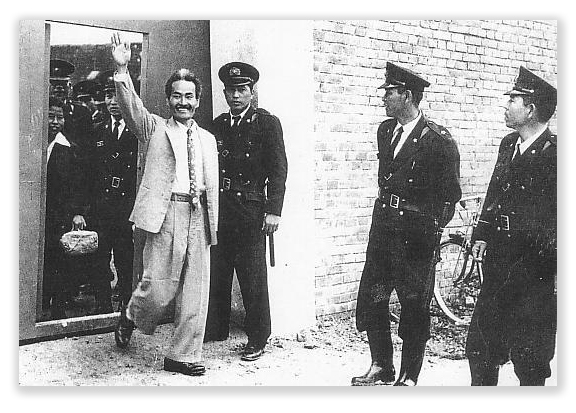We’re still doing a weekly newsletter… we’re just posting pieces of it every day. The news is fresher this way…

BOP HALFWAY HOUSE PROGRAM FOUND TO BE DEFICIENT
Recall those movies that start with the protagonist walking out of the prison doors wearing a cheap suit and carrying a cardboard suitcase? It doesn’t happen like that in the federal system anymore – or does it?
 Congress has mandated that the Federal Bureau of Prisons (BOP) provide a variety of reentry programming to help inmates successfully transition back into society. 18 U.S.C. Sec. 3624 grants the BOP authority to place inmates in residential reentry centers (RRCs) – also known as halfway houses – or in home confinement while serving the final portion of their sentences. Unsurprisingly, to many federal inmates, pursuit of the maximum amount of halfway house/home confinement time is a consuming activity while in prison.
Congress has mandated that the Federal Bureau of Prisons (BOP) provide a variety of reentry programming to help inmates successfully transition back into society. 18 U.S.C. Sec. 3624 grants the BOP authority to place inmates in residential reentry centers (RRCs) – also known as halfway houses – or in home confinement while serving the final portion of their sentences. Unsurprisingly, to many federal inmates, pursuit of the maximum amount of halfway house/home confinement time is a consuming activity while in prison.

RRCs are intended to provide a supervised environment that is intended to help inmates find employment and housing, complete programs like the BOP’s residential drug abuse program (called “RDAP”), participate in counseling, and re-establish ties to family. The RRCs are usually run by nonprofit organizations (the Salvation Army, Volunteers of America, and various ministries, for example). Currently, the BOP uses 181 RRCs operated by 103 different contractors.
Home confinement is the pot of gold, used for inmates whom the BOP believes do not need the structure provided by RRCs. Inmates in home confinement are electronically monitored, and are required to remain at home when not working or participating in release programing and other approved activities.
Under the Second Chance Act of 2007, all federal inmates are eligible for RRC and home confinement placement. But not all inmates get the programs. Rather, placement decisions are made initially by an inmate’s case manager, a BOP employee assigned to oversee inmate progress and planning. A case manager generally has from 100 to 200 inmates on his or her caseload, and – while guided by BOP policy – has great latitude in the decisions he or she makes about the inmates the case manager oversees.
The greatest single decision made by BOP case managers is the duration of RRC assignments for inmates. The law cabins their discretion only on the high end: no one may placed in RRCs for up to 12 months, but may only spend the lesser of 6 months or 10% of his or her sentence in home confinement. But nothing acts as a hard stop on the other end.
A report issued by the Dept. of Justice Office of the Inspector General earlier this week made that point. Its numbers are sobering, but will come as no surprise to federal inmates.

First, out of 94,000 federal inmates released during the study period (Oct. 2013 through April 2016), only 75% were sent to an RRC and a scant 4% went to home confinement. One out of five inmates went directly to the street.
The OIG found that, contrary to the BOP’s policy, guidance, and relevant research, the agency’s RRC and home confinement placement decisions are not based on inmate risk for recidivism or need for transitional services. Rather, BOP is “placing the great majority of eligible inmates into RRCs regardless of inmate risk for recidivism or need for transitional services, unless the inmate is deemed not suitable for such placement because the inmate poses a significant threat to the community. As a result, low-risk, low-need inmates are far more likely to be placed in RRCs than high-risk, high-need inmates.”
The numbers tell the story. During the study period, receive placed in RRC/home confinement placement. But only 58% of high security level inmates got such placement, while 42% of high security prisoners were released into the community directly from a BOP institution. While the OIG Report conceded that this “may be a result of the fact that many of the high security inmates were considered a public safety risk.,” still, the Report suggested that because, on the average, the high-security inmates were within four months of release anyway, there didn’t seem to be much justification for not sending them to a halfway house, where they (and the community) might benefit from receiving reentry programming.
The study also found that the BOP is underutilizing home confinement placement as an alternative to RRCs for low-risk, low-need inmates back into society. Even with minimum and low security inmates, the BOP placed only 6% directly into home confinement “despite BOP policy and guidance stating that direct home confinement placement is the preferred placement for low-risk, low-need inmates.” This makes no sense financially: the average cost to incarcerate a federal inmate is $88.00 a day. The cost of an RRC is about $71.00 a day. The costs of home confinement costs run about $8.00 per day.
Of even more concern, the Report noted, the BOP’s own research indicates that “low-risk inmates do not benefit from and may in fact be harmed by RRC placement because, among other things, of their exposure to high-risk offenders in those facilities. Moreover, the underutilization of direct home confinement for low-risk, low need inmates results in fewer RRC resources being available for high-risk, high-need inmates since the RRC inmate population is already at or in excess of BOP’s contracted capacity. In addition, this practice may also further strain high security BOP institutions that are already well above capacity.”
 During the study period, RRC population remained at about 101% of contracted capacity, while the home confinement population averaged nearly 159% of contracted monitoring capacity, despite BOP’s apparent underutilization of the home confinement alternative. The home confinement capacity remained high because the BOP pursues a policy of “aggressively… transitioning inmates from RRCs to home confinement as soon as possible in an effort to increase RRC capacity. This practice, the Report said, “reduces the capacity for direct home confinement placements and, additionally, may result in inmates being transitioned from RRCs to home confinement too early, as evidenced by the fact that 17% of inmates were placed back into RRCs for violating home confinement program rules.”
During the study period, RRC population remained at about 101% of contracted capacity, while the home confinement population averaged nearly 159% of contracted monitoring capacity, despite BOP’s apparent underutilization of the home confinement alternative. The home confinement capacity remained high because the BOP pursues a policy of “aggressively… transitioning inmates from RRCs to home confinement as soon as possible in an effort to increase RRC capacity. This practice, the Report said, “reduces the capacity for direct home confinement placements and, additionally, may result in inmates being transitioned from RRCs to home confinement too early, as evidenced by the fact that 17% of inmates were placed back into RRCs for violating home confinement program rules.”
The study found that the BOP’s RRC/home confinement targets – 85% from minimum, 75% from low, 70% from medium, and 65% from high security level institutions – seem to be snatched out of thin air, with no regard for the transitional needs of the inmates. In fact, the Report concluded, “issues we identified with BOP’s current placement practices may be driven, in part, by its RRC and home confinement placement targets. “
The bottom line? The BOP treats pre-release inmates as figures on a ledger, not as people with individual needs and abilities. The inmates who arguably need the most reentry training – guys who have done a lot of hard time in high-security settings – are the ones who get the least, due in part to BOP fear that they’ll misbehave which still in nominal BOP custody. The people getting the most halfway house time are the people who need it the least, minimum-security people.
U.S. Dept. of Justice Office of Inspector General, Audit of the Federal Bureau of Prisons’ Management of Inmate Placements in Residential Reentry Centers and Home Confinement (Audit Report 17-01, Nov. 15, 2016)

